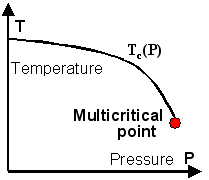Multicritical point
Multicritical points are special points in the parameter space of thermodynamic or other systems with a continuous phase transition. At least two thermodynamic or other parameters must be adjusted to reach a multicritical point. At a multicritical point the system belongs to a universality class different from the "normal" universality class.
A more detailed definition requires concepts from the theory of critical phenomena, a branch of physics that reached a very satisfying state in the 1970s.
Definition
The union of all the points of the parameter space for which the system is critical is called a critical manifold.

As an example consider a substance ferromagnetic below a
transition temperature  , and paramagnetic above
, and paramagnetic above  . The parameter space here is
the temperature axis, and the critical manifold consists of the point
. The parameter space here is
the temperature axis, and the critical manifold consists of the point  . Now add
hydrostatic pressure
. Now add
hydrostatic pressure  to the parameter space. Under hydrostatic pressure the substance
normally still becomes ferromagnetic below a temperature
to the parameter space. Under hydrostatic pressure the substance
normally still becomes ferromagnetic below a temperature  (
( ).
).
This leads to a
critical curve in the ( ) plane - a
) plane - a  -dimensional critical manifold. Also taking into account
shear stress
-dimensional critical manifold. Also taking into account
shear stress  as a thermodynamic parameter leads to a critical surface
as a thermodynamic parameter leads to a critical surface  (
( ) in the
(
) in the
( ) parameter space - a
) parameter space - a  -dimensional critical manifold.
Critical manifolds of dimension
-dimensional critical manifold.
Critical manifolds of dimension  and
and  may have physically reachable borders of dimension
may have physically reachable borders of dimension
 which in turn may have borders of dimension
which in turn may have borders of dimension  . The system still is critical at
these borders. However, criticality terminates for good reason, and the points on the
borders normally belong to another universality class than the universality class realized
within the critical manifold. All the points on the border of a critical manifold are
multicritical points.
Instead of terminating somewhere critical manifolds also may branch or intersect.
The points on the intersections or branch lines also are multicritical points.
. The system still is critical at
these borders. However, criticality terminates for good reason, and the points on the
borders normally belong to another universality class than the universality class realized
within the critical manifold. All the points on the border of a critical manifold are
multicritical points.
Instead of terminating somewhere critical manifolds also may branch or intersect.
The points on the intersections or branch lines also are multicritical points.
At least two parameters must be adjusted to reach a multicritical point.
A  -dimensional critical manifold may have two
-dimensional critical manifold may have two  -dimensional borders intersecting at a point. Two parameters must be adjusted to reach such a border, three parameters must be adjusted to reach the intersection of the two borders. A system of this type represents up to four universality classes: one within the critical manifold, two on the borders and one on the intersection of the borders.
-dimensional borders intersecting at a point. Two parameters must be adjusted to reach such a border, three parameters must be adjusted to reach the intersection of the two borders. A system of this type represents up to four universality classes: one within the critical manifold, two on the borders and one on the intersection of the borders.
The gas-liquid critical point is not multicritical, because the phase transition at
the vapour pressure curve  (
( ) is discontinuous and the critical manifold thus consists of a single point.
) is discontinuous and the critical manifold thus consists of a single point.
Examples
Tricritical Point and Multicritical Points of Higher Order
To reach a tricritical point the parameters must be tuned in such a way that the renormalized counterpart of the  -term of the Hamiltonian vanishes. A well-known experimental realization is found in the mixture of Helium-3 and Helium-4.
-term of the Hamiltonian vanishes. A well-known experimental realization is found in the mixture of Helium-3 and Helium-4.
Lifshitz Point
To reach a Lifshitz point the parameters must be tuned in such a way that the renormalized counterpart of the  -term of the Hamiltonian vanishes. Consequently, at the Lifshitz point phases of uniform and modulated order meet the disordered phase. An experimental example is the magnet
MnP. A Lifshitz point is realized in a prototypical way in the ANNNI model.
-term of the Hamiltonian vanishes. Consequently, at the Lifshitz point phases of uniform and modulated order meet the disordered phase. An experimental example is the magnet
MnP. A Lifshitz point is realized in a prototypical way in the ANNNI model.
Lifshitz Tricritical Point
This multicritical point is simultaneously tricritical and Lifshitz. Three parameters must be adjusted to reach a Lifshitz tricritical point. Such a point has been discussed to occur in non-stoichiometric ferroelectrics.
Renormalization Group
The renormalization group provides a detailed and quantitative explanation of critical phenomena.